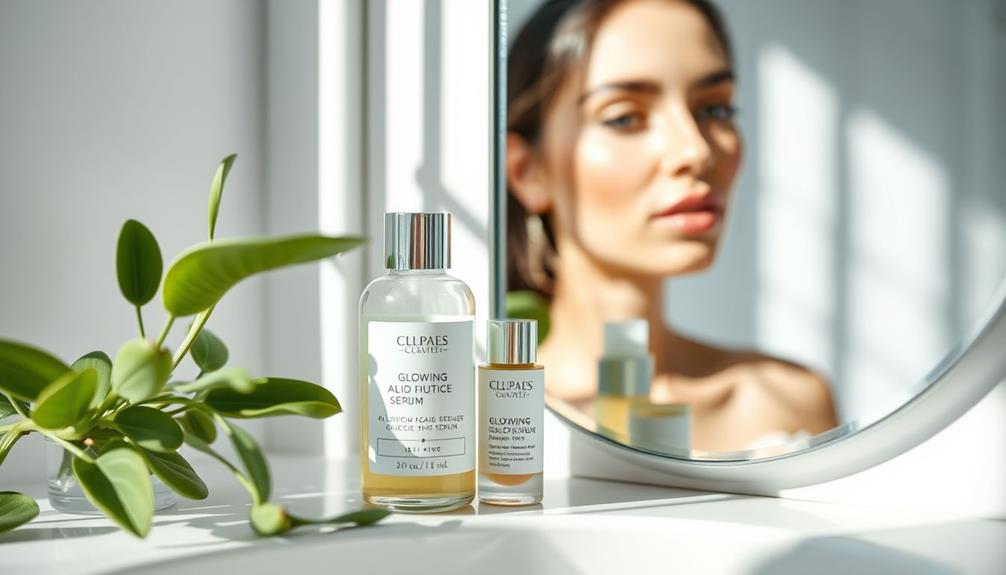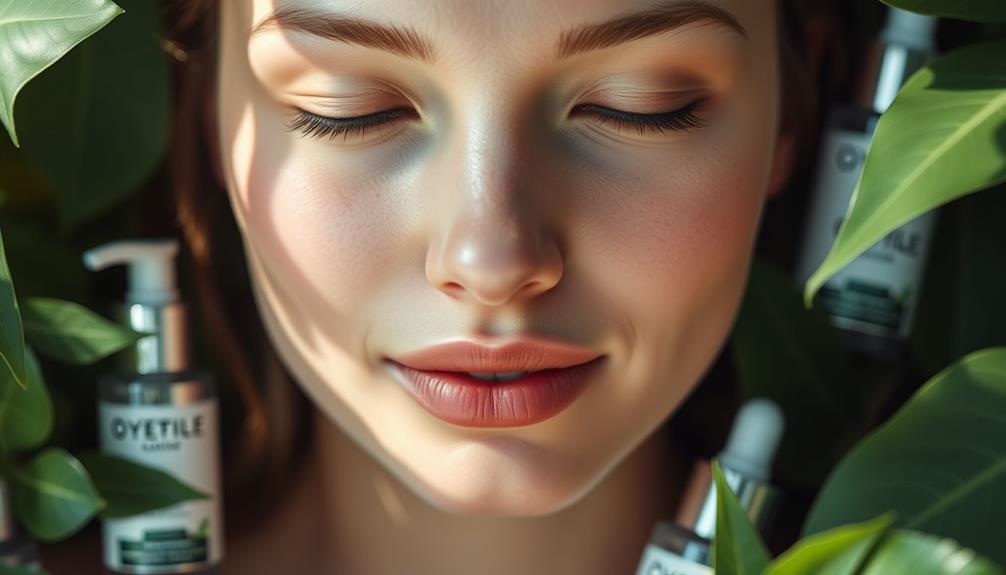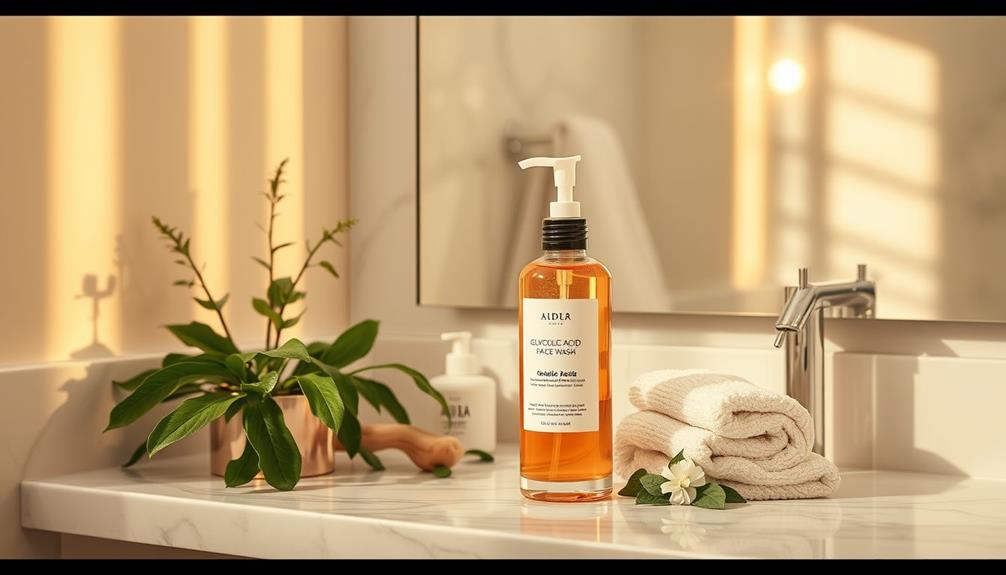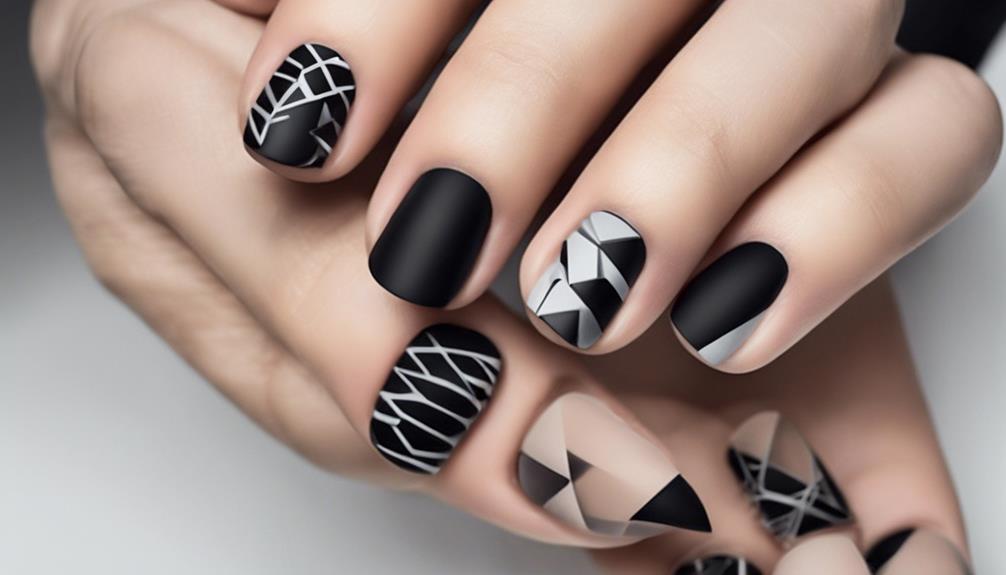Yes, glycolic acid can minimize the appearance of your pores. This powerhouse exfoliant, derived from sugar cane, effectively removes dead skin cells that can clog pores. When you use glycolic acid regularly, it helps reduce excess oil and promotes a smoother skin texture. Concentrations up to 10% are safe for home use, while higher levels may require professional assistance. It's also beneficial for all skin types, not just oily or acne-prone. If you're curious about how to incorporate this into your routine or other treatments, there's much more to uncover. Additionally, the glycolic acid benefits for acne are numerous. It can effectively unclog pores and reduce inflammation, which are common contributors to acne breakouts. The exfoliating properties of glycolic acid also help to fade acne scars and hyperpigmentation, promoting a more even skin tone. When used in combination with other acne-fighting ingredients, such as salicylic acid or benzoyl peroxide, glycolic acid can be a powerful tool in your skincare arsenal for combating breakouts.
Key Takeaways
- Glycolic acid promotes exfoliation, effectively removing dead skin cells that can clog pores and enhance their appearance.
- Regular use of glycolic acid can lead to minimized pore visibility and a smoother skin texture.
- A concentration of 5% glycolic acid is effective for improving skin tone and reducing discoloration linked to pore appearance.
- Combining glycolic acid with non-comedogenic moisturizers can provide hydration while preventing further clogging of pores.
Understanding Glycolic Acid

Glycolic acid, an alpha-hydroxy acid derived from sugar cane, plays an important role in exfoliating your skin by speeding up cell turnover and enhancing its texture.
As you incorporate glycolic acid into your skin care routine, you'll notice its powerful ability to exfoliate dead skin cells. This process not only helps improve your overall skin texture but also aids in reducing the appearance of clogged pores.
Additionally, combining glycolic acid with certain natural ingredients, like essential oils, can further enhance skin health and promote a healthy glow, making it a great choice for your skincare regimen. Essential oils for skin care can provide added benefits, such as hydration and soothing properties.
By promoting cell turnover, glycolic acid encourages fresh skin to surface, revealing a more radiant complexion. Regular use can lead to a significant improvement in tone, making your skin look brighter and healthier.
Unlike harsher exfoliants, glycolic acid gently sloughs away the buildup of dead skin cells without causing irritation, which is essential for maintaining a balanced complexion.
You can find glycolic acid in various skincare products, from cleansers to serums, with a concentration of up to 10% recommended for home use. Higher concentrations should only be applied by professionals.
With consistent application, you'll likely see a noticeable difference in your skin's texture and tone, making glycolic acid a standout ingredient in your quest for clearer, smoother skin.
How Glycolic Acid Affects Pores

Incorporating glycolic acid into your skincare routine can greatly impact the appearance and health of your pores. This alpha-hydroxy acid promotes exfoliation, effectively removing dead skin cells that can clog pores and lead to enlarged appearances.
If you have oily or acne-prone skin, glycolic acid is particularly beneficial; it helps clear excess oil and debris, considerably reducing the risk of enlarged pores. Additionally, regular use of essential oils such as lavender oil can complement your skincare regimen by promoting relaxation and enhancing overall skin health.
Regular use of glycolic acid enhances your skin's natural repair response and stimulates collagen production. This not only contributes to a smoother skin texture but also minimizes fine lines and wrinkles, further improving pore visibility.
Additionally, at a concentration of just 5%, glycolic acid can improve skin tone and reduce discoloration, which also plays a role in making pores appear smaller.
Effective Skincare Routine

An effective skincare routine focuses on cleansing, exfoliating, and moisturizing to keep your pores clear and minimize their appearance.
Start with a gentle, oil-free cleanser to remove dirt and excess oil, which helps prevent clogged pores. Regular trims can also contribute to healthier skin by promoting a balanced appearance; consider exploring local salons with positive customer reviews.
Exfoliation is essential; incorporate glycolic acid or other chemical exfoliants 1-2 times a week to promote cell turnover and eliminate dead skin cells. This process aids in reducing oil production and improving overall skin texture.
After cleansing and exfoliating, use non-comedogenic moisturizers, like those containing hyaluronic acid, to maintain hydration without clogging your pores. Hydrated skin appears plumper and smoother, which can diminish the look of pores.
Don't forget the sunscreen! Daily application of broad-spectrum SPF 30+ protects your skin from UV damage that can enlarge pores over time.
Professional Treatments for Pore Minimization

Are you looking to minimize the appearance of pores? Professional treatments can offer considerable improvements.
Chemical peels, for instance, provide deeper exfoliation, enhancing skin texture and reducing enlarged pores. If you want to stimulate collagen production, microneedling is an excellent choice. This technique boosts skin elasticity, resulting in a smoother surface and less visible pores.
Laser therapies, such as fractional laser and IPL (Intense Pulsed Light), effectively target skin texture. These treatments promote skin tightening and rejuvenation, leading to a remarkable reduction in pore appearance.
Additionally, Hydrafacials combine cleansing, exfoliation, and hydration in one session, efficiently removing impurities and minimizing pore size while improving overall skin health.
To optimize results, consider regular consultations with dermatologists. They can tailor professional treatments, including microdermabrasion, to your individual skin needs and concerns. This personalized approach guarantees you get the most effective care for pore reduction, helping you achieve the smooth, clear skin you desire.
Whether you opt for chemical peels, microneedling, or laser therapies, these professional treatments can considerably enhance your skin's texture and minimize the appearance of pores.
Common Myths About Glycolic Acid

Many people fall for common myths about glycolic acid, which can lead to misunderstandings about its benefits and uses in skincare. Here are a few misconceptions you might've heard:
- Glycolic acid can permanently shrink pores.
- It's only suitable for oily or acne-prone skin.
In reality, glycolic acid doesn't permanently shrink pores; it minimizes their appearance by promoting exfoliation and removing dead skin cells that clog them.
It's a versatile ingredient that works for all skin types, including sensitive skin, especially when you use the right concentration and follow up with adequate moisturizing.
Another myth suggests that glycolic acid is too drying. Contrary to that belief, it can actually stimulate the production of glycosaminoglycans to help maintain hydration.
While some worry about irritation, gentle formulations can soothe conditions like eczema and reduce redness.
Finally, it's possible to combine glycolic acid with other active ingredients; just be cautious to avoid irritation.
Understanding these facts can empower you to make informed choices for your skincare routine and truly enjoy the benefits of glycolic acid.
Frequently Asked Questions
Can Glycolic Acid Reduce Pore Size?
Glycolic acid can effectively reduce pore size. By exfoliating dead skin cells and preventing clogs, it promotes clearer pores, improves skin texture, and supports collagen production, leading to a smoother, more refined appearance over time.
How Long Does Glycolic Acid Take to Unclog Pores?
You might think your pores are stubborn little creatures, but with consistent glycolic acid use, you'll see them start to unclog within just 1-2 weeks. Just remember to start slow and be gentle on your skin!
Which Acid Is Best for Shrinking Pores?
When it comes to shrinking pores, glycolic acid and salicylic acid are top contenders. Glycolic exfoliates the surface while salicylic dives deeper, targeting oil. Determine your skin type to choose the best option for you.
What Strength Glycolic Acid Do Dermatologists Use?
Imagine your skin feeling smooth and rejuvenated. Dermatologists often use glycolic acid concentrations between 20% to 70% for peels, while recommending at-home products with 5% to 10% for effective, gentle exfoliation without irritation.
Conclusion
So, if you're dreaming of poreless perfection, grab that glycolic acid like it's the Holy Grail!
Picture your pores shrinking like a wool sweater in hot water.
Sure, it won't make you flawless overnight, but with consistent use, you might just fool people into thinking you've got the skin of a porcelain doll.
Just remember, even the best potions can't work magic without a solid skincare routine—so don't forget to hydrate and moisturize, or you'll be left with a desert!









